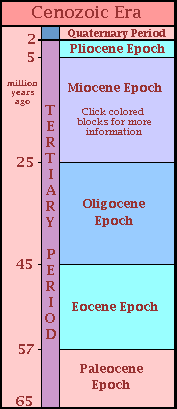Table 1 Table 2
Table 1is from http://www.stonecompany.com/geotime/images/eralace.GIF
Table 2 is from http://www.stonecompany.com/geotime/images/cenozoic.GIF

Table 1 Table 2Table 1is from http://www.stonecompany.com/geotime/images/eralace.GIF
Table 2 is from http://www.stonecompany.com/geotime/images/cenozoic.GIF
Cenomanian(96-92 Ma)
The earliest moist megathrmal forests were developed.
It may not have been identical to our classic impressions of present-day tropical rain forests(multistratal communities), but more likely they were single-stratum open forests.Paleocene (66-54 Ma)
In Early Paleocene(66-60 Ma), closed, multistratal, tropical aspect rain forests became widespread in each of the three moist megathermal belts( Boreotropical, Palmae, and Southern Megathermal, from north to south).
The diversification of mammals, such as dinasaurs, which developed fruit and seed eating, and helped seed dispersal of large, closed-canopy trees.In the end of the Paleocene(60-54 Ma), the the floras of the Boreotropical and Southern Megathermal Provinces expanded poleward, mainly because of the climate change.
Eocene (54-36 Ma)
Tropical aspect and paratropical rain forests and widespread mangroves became established over much of Europe and North America.
the warm periods continued into the Late Eocene(39-36 Ma) in North America, whereas in Europe there was a tendency toward cooler climates after the Mi
In the Middle and Late Eocene, equatorial floras were characterised by the appearance of many elements of modern aspect in each of the three tropical bolook. (the isolation of South America and Africa, which led to the different floras evolved).The terminal Eocene event (36 Ma)
The cooling event occurred.
megathermal elements of the Boreotropical Province virtually disappeared from northrn mid-latitudes.Middel Miocene(16-10 Ma)
Climatic amelioration.
Renewd global warming during the latest Early and earliest Middle Miocene resulted once.
Epoch Northern Southern Plio-Pleist (5 - 2 Ma) Northern neotropical Southern neotropical Nothofagus Miocene (25 - 5 Ma) Northern neotropical Southern neotropical Nothofagus Oligocene (45 - 25 Ma) Neotropical Mixed (former)Mixed / (latter)Nothofagus) Eocene (57 - 45 Ma) Neotropical Mixed Mixed Paleocene (65 - 57 Ma) Palmae Mixed Mixed PaleoceneNet tropical climates enabled the development of diverse vegetation.Eocene
Palmae ---- Diverse Palmar, megathermal taxa;
Mixed --- megathermal elements, southern hemisphere taxaCharacterized Plants --- palms (considerable diversity)
Key Species: manglove palm (nypa, mauritia, longapertites, etc.), Megathermal taxa (Anacolosa, ctenolophon, bombacaceae, annoaceae, proxapertites, etc.) --- in Palmae
pollen of casuarina, beauprea, nothofugns, gunnera, restionaceae etc.; conifers of podocarpus, microcachrys, etc. ; macrofossil of cunoniaceae, peumus, etc. --- in Mixed
The cooling event all over the world ---> less effect on South America. (this is considered to be one of the reasons of th high genetic diversity of Palmae in SouthAmerica.)Oligoceneearly --- well represented by palm pollen (mauritia, etc.)
middle --- pollen of annonaceae, gramineae, cruclin, coryocar, mirabilis, etc.
latter ---- mangroves with rhizophora in North South Amrica
subhumid wooded savannas became widespread in S South America
Grass-dominated vegitation in North AmericaMincerie and so on
2.7 Ma --- Sudden Cooling
2.2 - 1.0 Ma --- cold periodHowever, the desiccation associated with glacial maxima were not pronounced in South America as in Africa. ---> which enabled the survival of very diverse rain forest communities through the most unfavorable,periods of the Pleistocene)